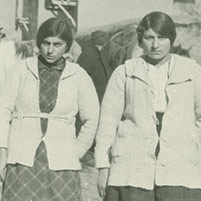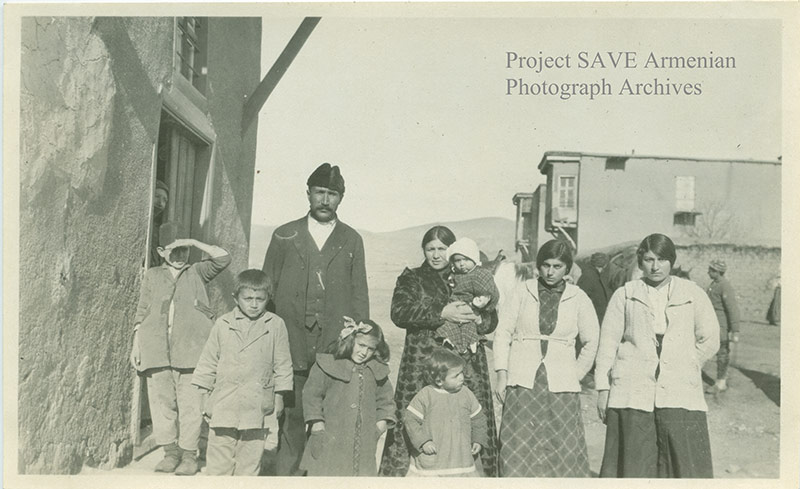Rare Armenian Photographs Now Available in IWitness

Rare primary-source photographs that focus on the life and culture of the Armenian people before the Armenian Genocide and the resiliency among the ensuing diaspora have been integrated into USC Shoah Foundation’s award-winning IWitness educational website.
The addition comes thanks to a new partnership with Project SAVE Armenian Photograph Archives, whose mission is to collect, document, preserve, and present the historic and modern photographic record of Armenians and Armenian heritage.
 This photograph is one of many from the album of Near East Relief volunteer worker Ruth Woodis of Worcester, Massachusetts from the early 1920s. With her Brownie box camera, Ruth photographed daily living situations. She was in charge of food and clothing for the Armenian orphans, and trained them in the tailor and shoe shops. The woman second from the right is Haiastan Terzian, who was a mayrig (caregiving mother) of the Near East Relief orphanage in Kharpert, Ottoman Empire, where Ms. Woodis worked. This photograph is courtesy of Ruth Woodis.
This photograph is one of many from the album of Near East Relief volunteer worker Ruth Woodis of Worcester, Massachusetts from the early 1920s. With her Brownie box camera, Ruth photographed daily living situations. She was in charge of food and clothing for the Armenian orphans, and trained them in the tailor and shoe shops. The woman second from the right is Haiastan Terzian, who was a mayrig (caregiving mother) of the Near East Relief orphanage in Kharpert, Ottoman Empire, where Ms. Woodis worked. This photograph is courtesy of Ruth Woodis.IWitness users can now access a curated selection of images from Project SAVE Archives within the “Images” database and the number will continue to increase. As a result of this integration, students will be able to conduct research, corroborate sources, and use the photographs in their uniquely produced work, including video editing projects and GeoStory timelines.
The first release of 70 images aims to complement the 70 testimonies of Armenian Genocide survivors and witnesses currently available in IWitness. This set of photographs uniquely tell stories, not often told, through geographic features and changes in historic Armenian populated regions, economic prosperity of Armenians throughout the Ottoman Empire prior to genocide and personal stories of resiliency after persecution, violence, and loss of family members.
In order to realize this partnership, USC Shoah Foundation’s Education and Outreach Specialist, Sedda Antekelian has visited the Project SAVE headquarters in Massachusetts twice to research and obtain some 200 images that will be integrated into IWitness by December.
“By including Project SAVE’s iconic photographs into IWitness, we are further providing students with a well-rounded understanding of how genocide interrupts the everyday lives of people and alters the story of their survival,” said Antekelian, “We are honored to host these images on our site, as they tell stories of real people that will build student empathy and personal responsibility.”
Antekelian’s efforts would not be possible without the guidance and support of Project SAVE’s Executive Director Tsoleen Sarian and Archivist Suzanne Adams.
“By expanding the IWitness program to include Armenian photographs from Project SAVE, this collaboration will afford teachers and students the opportunity to gain insight to a more complete story of the Armenian people, from pre-genocide to post-genocide,” Sarian said.
An already notable discovery from Antekelian’s corroborative research of Project SAVE’s photographs with the Institute’s Armenian Genocide testimony collection is the identification of an Armenian survivor, Haiastan Terzian, labeled as “unidentified” in a Project SAVE photograph from a Near East Relief humanitarian worker. Having watched Terzian’s 1991 recorded interview in IWitness, Antekelian recognized that Terzian shares a copy of the same photo with her interviewer at the end of her testimony.
Next on the agenda will be the creation of a multimedia activity, which highlights the value of collective memory and cultural preservation through photographs and testimony.
IWitness provides access to more than 2,500 first-person accounts of survivors and witnesses to genocides for guided exploration, bringing human stories of the Institute’s Visual History Archive® to more than 100,000 secondary school educators and students in 80 countries. The collaboration between USC Shoah Foundation and Project SAVE will expose the rare photograph collection to these diverse audiences and will complement the mission of the IWitness Armenian Genocide Education program, which strives to teach a holistic story of Armenian Genocide and its lasting legacy.
Founded by Ruth Thomasian in 1975, Project SAVE’s extensive and diverse collection of more than 45,000 photographs, depict all aspects of Armenian life in the homeland and Diaspora, from the 1860s to the present. Project SAVE strives to increase knowledge of Armenian culture and heritage by encouraging the use of its collection of photographs by the widest possible audience.
To learn more about USC Shoah Foundation’s IWitness platform, please visit http://iwitness.usc.edu. To learn more about Project SAVE Armenian Photograph Archives, Inc., please visit http://projectsave.org/.
Like this article? Get our e-newsletter.
Be the first to learn about new articles and personal stories like the one you've just read.